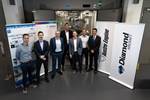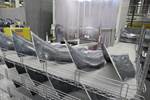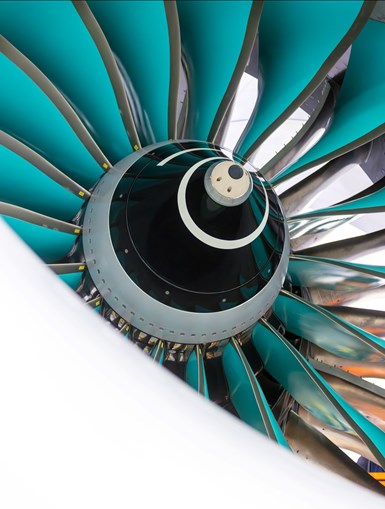Rolls-Royce successfully tests UltraFan aeroengine demonstrator
First tests with sustainable aviation fuel (SAF) were performed at a large, indoor aeroengine testing facility in Derby, U.K., advancing the UltraFan’s decade-long development.
Rolls-Royce (London, U.K.) announces it has successfully completed the first tests of its UltraFan technology demonstrator at its facility in Derby, U.K. The first tests were conducted using 100% sustainable aviation fuel (SAF).
UltraFan, which Rolls-Royce says will be the world’s largest aeroengine and will contribute to sustainable air travel, features what will be the world’s largest fan rotor blades made from carbon fiber-reinforced polymer (CFRP). It features a novel Advance3 core architecture, combined with Roll-Royce’s ALECSys lean burn combustion system, to deliver maximum fuel burn efficiency and low emissions; carbon fiber-titanium fan blades and a composite casing; and a geared design that delivers efficient power for the high-thrust, high bypass ratio engines of the future — the power gearbox has run at 64 megawatts, an aerospace record.
Confirming the capability of the suite of technologies incorporated in the demonstrator is an important step toward improving the efficiency of current and future aeroengines. UltraFan is said to deliver a 10% efficiency improvement over the Trent XWB, one of the most efficient large aeroengines in service.
In the nearer term, Rolls-Royce says, there are options to transfer technologies from the UltraFan development program to current Trent engines, providing customers with greater availability, reliability and efficiency. In the longer term, UltraFan’s scalable technology from ~25,000-110,000 pound thrust offers the potential to power new narrowbody and widebody aircraft anticipated in 2030 and beyond.
“The UltraFan demonstrator is a game changer — the technologies we are testing as part of this program have the capability to improve the engines of today as well as the engines of tomorrow,” Tufan Erginbilgic, Rolls-Royce plc CEO says. “That is why this announcement is so important — we are witnessing history in the making; a step-change in engine efficiency improvement. Collaboration is key in driving the decarbonization of air travel and the UltraFan program is a great example of what can be achieved when government and industry come together with a common purpose.”
The tests took place in Testbed 80, a large indoor aeroengine testing facility. The 100% SAF, derived primarily from waste-based sustainable feedstocks such as used cooking oils, was provided by Air BP (Middlesex, U.K.).
Testing the demonstrator is the culmination of many years of work, which has been supported by the U.K. government through the Aerospace Technology Institute (ATI), Innovate UK; the EU’s Clean Sky programs; and LuFo and the state of Brandenburg in Germany.
UltraFan has been a decade in the making, with the concept unveiled publicly in 2014. It is a fundamentally different design architecture to that within the approximately 4,200 Rolls-Royce civil large engines currently in service, as it incorporates a geared design that the company claims no industry player has produced at this size before. Demonstrating at this scale gives the flexibility to scale down as required by customers, and to offer a portfolio of two-shaft, three-shaft, direct drive and geared propulsion solutions to power future aircraft.
The UltraFan technology demonstrator’s architecture, a flagship project of the Clean Sky 2 program, will be further developed through Clean Aviation’s HEAVEN project.
Related Content
Materials & Processes: Resin matrices for composites
The matrix binds the fiber reinforcement, gives the composite component its shape and determines its surface quality. A composite matrix may be a polymer, ceramic, metal or carbon. Here’s a guide to selection.
Read MoreThe making of carbon fiber
A look at the process by which precursor becomes carbon fiber through a careful (and mostly proprietary) manipulation of temperature and tension.
Read MoreThermoplastic composites welding advances for more sustainable airframes
Multiple demonstrators help various welding technologies approach TRL 6 in the quest for lighter weight, lower cost.
Read MoreMaterials & Processes: Fabrication methods
There are numerous methods for fabricating composite components. Selection of a method for a particular part, therefore, will depend on the materials, the part design and end-use or application. Here's a guide to selection.
Read MoreRead Next
Austro Engine researches future propulsion systems for general aviation
A sister company to composite airframer manufacturer Diamond Aircraft, Austro Engine collaboratively studies an ignition jet option using sustainable aviation fuels for reduced emission results.
Read MorePlant tour: Albany Engineered Composites, Rochester, N.H., U.S.
Efficient, high-quality, well-controlled composites manufacturing at volume is the mantra for this 3D weaving specialist.
Read MoreFrom the CW Archives: The tale of the thermoplastic cryotank
In 2006, guest columnist Bob Hartunian related the story of his efforts two decades prior, while at McDonnell Douglas, to develop a thermoplastic composite crytank for hydrogen storage. He learned a lot of lessons.
Read More




















.jpg;maxWidth=300;quality=90)







